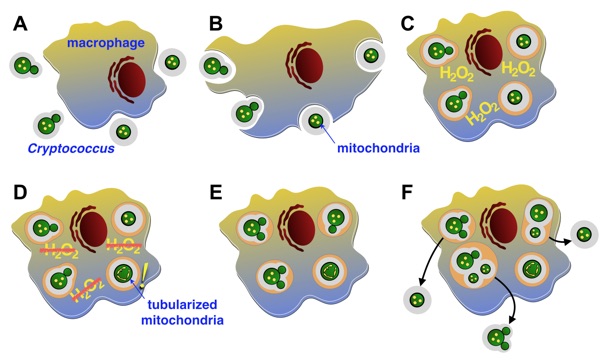The diagram below represents the ‘division of labour’, how Cryptococcus gattii is able to survive in the immune system’s cells (the macrophages). Cryptococcus gattii is a sneaky pathogen which makes the macrophage a cosy environment in which to survive, instead of being destroyed. MitoFun aims to understand how this works and how to prevent it.

This diagram shows that:
-
A.A macrophage is hunting for intruders. A macrophage is a large white blood cell in the body that ingests foreign particles & infectious microorganisms by a process known as phagocytosis. The intruders are pathogens – bacteria, viruses or other microorganisms that can cause disease (in this case Cryptococcus gattii fungal cells).
-
B.The fungal cells are phagocytosed (ie. ingested) by the macrophage. Note the shape of fungal mitochondria (in yellow).
-
C.The macrophage releases hydrogen peroxide (H202) to destroy the pathogens.
-
D.One of the pathogens becomes a ‘bodyguard’ of the other cells and destroys H202. This is associated with a change in shape of the mitochondria, which are now tubularised.
-
E.The other fungal cells start to multiply (proliferate).
-
F.Proliferated Cryptococci are released from the macrophage. Note that the guard cell does not proliferate.
Read more in our publication ‘“Division of labour” in response to host oxidative burst drives a fatal Cryptococcus gattii outbreak’, Voelz, Johnston A, Smith L, Hall R, Idnurm A, May R, Nature Communications, 2014, 5:5194.
This project is funded by the European Research Council under the European Union’s Framework 7 Programme (FP/2007-2013)/ERC Grant Agreement No. 614562


